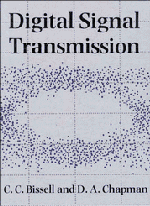Book contents
- Frontmatter
- Contents
- Preface
- 1 Introduction
- PART 1 MODELS
- PART 2 PROCESSES
- PART 3 DIGITAL TRANSMISSION OVER THE PUBLIC SWITCHED TELEPHONE NETWORK
- 7 Analogue and digital sources
- 8 Digital transmission hierarchies
- 9 An optical fibre link
- Appendix A Fourier series and transforms
- Appendix B Convolution
- Appendix C Modelling applications of spreadsheets
- Answers to numerical exercises
- References
- Index
8 - Digital transmission hierarchies
from PART 3 - DIGITAL TRANSMISSION OVER THE PUBLIC SWITCHED TELEPHONE NETWORK
Published online by Cambridge University Press: 05 June 2012
- Frontmatter
- Contents
- Preface
- 1 Introduction
- PART 1 MODELS
- PART 2 PROCESSES
- PART 3 DIGITAL TRANSMISSION OVER THE PUBLIC SWITCHED TELEPHONE NETWORK
- 7 Analogue and digital sources
- 8 Digital transmission hierarchies
- 9 An optical fibre link
- Appendix A Fourier series and transforms
- Appendix B Convolution
- Appendix C Modelling applications of spreadsheets
- Answers to numerical exercises
- References
- Index
Summary
Introduction
In chapter 7 reference was made to the multiplexing of 2048 kbits s-1 channels to exploit the high capacity of modern transmission media. Over any given route, the most cost-effective transmission will, in general, be achieved by multiplexing as many as possible of the channels together. As technology has advanced, it has become feasible to combine an increasing number of channels by operating at ever higher signalling rates. Some routes, of course, will only need a few channels, so will not require very high signalling rates. Transmission networks in the public switched telephone network, therefore, are designed around hierarchies of transmission rates, corresponding to increasing numbers of channels conveyed on a single multiplexed link. These hierarchies are defined in national and international standards. The first hierarchies to be standardised were those for plesiochronous multiplexing (see Section 8.2 below). Unfortunately several distinct plesiochronous hierarchies simultaneously exist in different locations around the world. In Europe the hierarchy is based upon the 30-channel 2048 kbit s-1 primary rate, while in the USA and Japan it is based upon the 24-channel 1544 kbits s-1 primary rate. Furthermore, although the US and Japanese hierarchies are the same at lower levels, they diverge at higher levels.
For reasons which are discussed below, more recently it has been decided to move to synchronously multiplexed transmission hierarchies. There has been a concerted attempt to ensure that a multiplicity of new hierarchies does not arise. The first standards for a synchronous hierarchy were the Synchronous Optical Network (SONET) standards of the American National Standards Institute (ANSI) in the USA.
Information
- Type
- Chapter
- Information
- Digital Signal Transmission , pp. 263 - 285Publisher: Cambridge University PressPrint publication year: 1992
